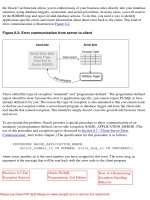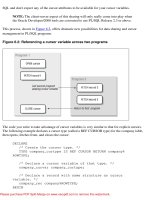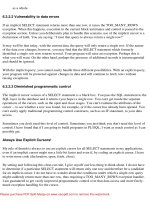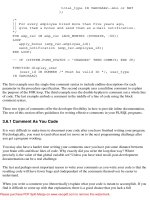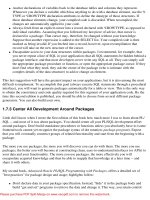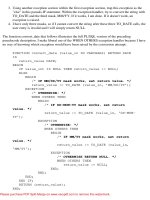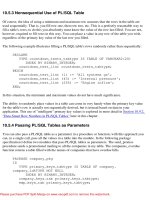Oracle RMAN Pocket Reference
Bạn đang xem bản rút gọn của tài liệu. Xem và tải ngay bản đầy đủ của tài liệu tại đây (1.18 MB, 115 trang )
Oracle RMAN Pocket Reference
•
Tabl e o f
Contents
• Reviews
•
Reader
Reviews
• Errata
Oracle RMAN Pocket Reference
By Darl Kuhn, Scott Schulze
Publisher : O'Reilly
Pub Date : November 2001
ISBN : 0-596-00233-5
Pages : 120
Copyright
Chapter 1. Oracle RMANPocket Reference
Section 1.1. Introduction
Section 1.2. RMAN Architecture
Section 1.3. Starting RMAN
Section 1.4. Executing Commands
Section 1.5. Implementing a Catalog
Section 1.6. Stored Catalog Scripts
Section 1.7. Backups
Section 1.8. Restoring Files
Section 1.9. RMAN Command Reference
Chapter 1. Oracle RMANPocket Reference
Section 1.1. Introduction
Section 1.2. RMAN Architecture
Section 1.3. Starting RMAN
Section 1.4. Executing Commands
Section 1.5. Implementing a Catalog
Section 1.6. Stored Catalog Scripts
Section 1.7. Backups
Section 1.8. Restoring Files
Section 1.9. RMAN Command Reference
1.1 Introduction
This book is a quick-reference guide for Recovery Manager (RMAN), Oracle's utility to manage all
of your Oracle database backup and recovery activities. This book is not a comprehensive backup
and recovery book. It contains an overview of RMAN architecture, shows briefly how to backup and
restore databases using RMAN, describes catalog setup issues, and provides quick-reference syntax
diagrams of RMAN commands.
The purpose of this book is to help you quickly find the syntax for, and use, RMAN commands to
back up, restore, and recover a database. We assume that you, the reader, have basic Oracle database
administrator (DBA) skills, and that you are familiar with backup and recovery concepts. We also
point out that the batch mode examples in this book are scripted with Unix shell scripts. Many of
these examples contain Unix paths that are appropriate for our environment. If you are developing
your own set of scripts, you will want to change the examples to reflect your own environment.
1.1.1 Acknowledgments
Many thanks to "our man," editor Jonathan Gennick. His feedback and suggestions have added
significant improvements and clarity to this book. Thanks also to the technical reviewers Jeff Cox,
Tim Gorman, Dick Goulet, Mark Hampton, Steve Orr, Walt Weaver, and Jeremiah Wilton.
1.1.2 Caveats
We have taken the Pareto's Law approach in writing this book, in that we have tried to cover topics
that you are most likely to encounter while using RMAN. This material does not cover every type of
environment, nor does it cover all of the backup and recovery scenarios that you will encounter as an
Oracle DBA.
While some of the more common backup and recovery scenarios are covered in this book, it is still
critical that you are comfortable with your RMAN implementation and can recover your database no
matter what type of failure occurs. We can't stress enough the importance of regular testing in
preparation for recovering from unplanned disasters.
A sound implementation and regular testing will give you the confidence to handle the impending 2
A.M. call: "Hey, I'm getting this strange ORA-01116 error, unable to open file, what do I do?"
1.1.3 Conventions
UPPERCASE
Indicates an RMAN keyword, SQL keyword, or the name of a database object.
italic
Used for filenames, directory names, and URLs. Also used for emphasis and for the first use
of a technical term.
Constant width
Used for examples showing code.
Constant width bold
Indicates user input in examples showing an interaction.
Constant width italic
Used in syntax descriptions to indicate user-defined terms.
[]
Used in syntax descriptions to denote optional elements.
{}
Used in syntax descriptions to denote a required choice.
|
Used in syntax descriptions to separate choices.
_
Used in syntax descriptions to indicate that the underlined option is the default.
O/S
Abbreviation of "operating system."
.2 RMAN Architecture
Recovery Manager (RMAN) is a utility that can manage all of your Oracle backup and recovery
activities. DBAs are often wary of using RMAN because of its perceived complexity and its control
over performing critical tasks. The traditional backup and recovery methods are tried-and-true. Thus,
when your livelihood depends on your ability to back up and recover the database, why implement a
technology like RMAN? The reason is that RMAN comes with several benefits:
•
Incremental backups that only copy data blocks that have changed since the last backup.
•
Tablespaces are not put in backup mode, thus there is no extra redo log generation during
online backups.
•
Detection of corrupt blocks during backups.
•
Parallelization of I/O operations.
•
Automatic logging of all backup and recovery operations.
•
Built-in reporting and listing commands.
RMAN's architecture is a combination of an executable program (the rman utility) and background
processes that interact with one or more databases and with I/O devices. There are several key
architectural components to be aware of:
•
RMAN executable
•
Server processes
•
Channels
•
Target database
•
Recovery catalog database (optional)
•
Media management layer (optional)
•
Backups, backup sets, and backup pieces
The following sections describe each of these components.
1.2.1 RMAN Executable
The RMAN executable, usually named rman, is the program that manages all backup and recovery
operations. You interact with the RMAN executable to specify backup and recovery operations you
want to perform.
You don't need an extra license for RMAN; it comes as a standard utility
included with an Oracle 8.0.x, Oracle8i, or Oracle9i installation.
The executable then interacts with the target database, starts the necessary server processes, and
performs the operations that you requested. Finally, the RMAN executable records those operations
in the target database's control file and the recovery catalog database, if you have one.
1.2.2 Server Processes
RMAN server processes are background processes, started on the server, used to communicate
between RMAN and the databases. They can also communicate between RMAN and any disk, tape,
or other I/O devices. RMAN server processes do all the real work for a backup or restore operation,
and a typical backup or restore operation results in several server processes being started.
Server processes are started under the following conditions:
•
When you start RMAN and connect to your target database
•
When you connect to your catalog -- if you are using a recovery catalog database
•
When you allocate and open an I/O channel during a backup or recovery operation
1.2.3 Channels
A channel is an RMAN server process started when there is a need to communicate with an I/O
device, such as a disk or a tape. A channel is what reads and writes RMAN backup files. Any time
you issue an RMAN allocate channel command, a server process is started on the target database
server. It is through the allocation of channels that you govern I/O characteristics such as:
•
Type of I/O device being read or written to, either a disk or an sbt_tape
•
Number of processes simultaneously accessing an I/O device
•
Maximum size of files created on I/O devices
•
Maximum rate at which database files are read
•
Maximum number of files open at a time
1.2.4 Target Database
The target database is the database on which RMAN performs backup, restore, and recovery
operations. This is the database that owns the datafiles, control files, and archived redo files that are
backed up, restored, or recovered. Note that RMAN does not back up the online redo logs of the
target database.
1.2.5 Recovery Catalog Database
The recovery catalog database is an optional repository used by RMAN to record information
concerning backup and recovery activities performed on the target. The recovery catalog consists of
three components:
•
A separate database referred to as the catalog database (from the target database)
•
A schema within the catalog database
•
Tables (and supporting objects) within the schema that contain data pertaining to RMAN
backup and recovery operations performed on the target
The catalog is typically a database that you build on a different host from your target database. The
reason for this is that you don't want a failure on the target host to affect your ability to use the
catalog. If both the catalog and target are on the same box, a single media failure can put you in a
situation from which you can't recover your target database.
Inside the catalog database is a special schema containing the tables that store information about
RMAN backup and recovery activities. This includes information such as:
•
Details about the physical structure of the target database
•
A log of backup operations performed on the target database's datafiles, control files, and
archived redo log files
•
Stored scripts containing frequently used sequences of RMAN commands
Why is the catalog optional? When RMAN performs any backup operation, it writes information
about that task to the target database's control files. Therefore, RMAN does not need a catalog to
operate. If you choose to implement a recovery catalog database, then RMAN will store additional
information about what was backed up -- often called metadata -- in the catalog.
A common misconception is that the catalog stores the physical backup files
for the target database. The catalog contains only information about the
backups of the target database -- not the physical backup files themselves.
The primary reason for implementing a catalog is that it enables the greatest flexibility in backup and
recovery scenarios. Using a catalog gives you access to a longer history of backups and allows you
to manage all of your backup and recovery operations from one repository. Utilizing a catalog makes
available to you all the features of RMAN. For reasons such as these, we recommend using a catalog
database.
The recovery catalog database is frequently referred to simply as the catalog
or the catalog database. We use both terms throughout this book.
1.2.6 Media Management Layer
The Media Management Layer (MML) is a third-party piece of software that manages the reading
and writing of files to and from tape. An MML also keeps track of which files have been written to
which tapes. If you want to back up your database files to tape, RMAN requires you to use an MML.
If you plan to use RMAN to back up files only to disk, you do not need an MML.
MML tools are often used by System Administrators to back up the host O/S filesystems. If your
work environment already uses a MML, you can leverage this architecture to implement RMAN
backups to tape. There are several reasons to back up files to tape and thus require an MML:
•
The expense of storing large backups on disk is too costly.
•
Your requirement is to back up files somewhere other than on the same server as the target
database, thus reducing your risk of losing both the target database and backup files at the
same time
When backing up files to tape, an MML keeps track of which files were written to which tapes. In
the event that restoration of a database file is required, RMAN communicates to the MML a list of
the backup files that are required to restore the database file. The MML then determines which tapes
contain the required backup files, retrieves the requested backup files, and passes them back to
RMAN; RMAN then restores the database file.
Setting up RMAN to work with an MML can be the most frustrating and difficult part of
implementing RMAN. This is because determining the root cause of an issue can be problematic
when multiple software vendors are involved.
1.2.7 Backups, Backup Sets, and Backup Pieces
When you issue an RMAN backup command, RMAN creates backup sets, which are logical
groupings of physical files. The physical files that RMAN creates on your backup media are called
backup pieces. When working with RMAN, you need to understand that the following terms have
specific meanings:
RMAN backup
A backup of all or part of your database. This results from issuing an RMAN backup
command. A backup consists of one or more backup sets.
Backup set
A logical grouping of backup files -- the backup pieces -- that are created when you issue an
RMAN backup command. A backup set is RMAN's name for a collection of files associated
with a backup. A backup set is composed of one or more backup pieces.
Backup piece
A physical binary file created by RMAN during a backup. Backup pieces are written to your
backup medium, whether to disk or tape. They contain blocks from the target database's
datafiles, archived redo log files, and control files.
When RMAN constructs a backup piece from datafiles, there are a several rules that it follows:
•
A datafile cannot span backup sets.
•
A datafile can span backup pieces as long as it stays within one backup set.
•
Datafiles and control files can coexist in the same backup sets.
•
Archived redo log files are never in the same backup set as datafiles or control files.
RMAN is the only tool that can operate on backup pieces. If you need to restore a file from an
RMAN backup, you must use RMAN to do it. There's no way for you to manually reconstruct
database files from the backup pieces. You must use RMAN to restore files from a backup piece.
1.3 Starting RMAN
This section explains some of the prerequisites that must be in place before you can use RMAN. It
then shows you how to invoke RMAN and finally, how to connect to a target database both with and
without using a recovery catalog.
1.3.1 Target Prerequisites
If you already have your target database environment set up, you can skip this section. If not, there
are a few things you need to have in place before instructing RMAN to connect to the target:
•
Appropriate target environment variables must be established.
•
You must have access to an O/S account or a schema that has SYSDBA privileges.
Before you connect to your target database, you must ensure that the standard Unix environment
variables are established. These variables include: ORACLE_SID, ORACLE_HOME, PATH,
NLS_LANG, and NLS_DATE_FORMAT. They govern the name of the instance, the path to the
RMAN executable; and the behavior of backup, restore, and reporting commands.
When using RMAN, NLS_LANG should be set to the character set that
your database was created with. If you do not set NLS_LANG, you may
encounter problems when issuing BACKUP, RESTORE, and RECOVER
commands.
Once you have the appropriate environment variables set, you then need access to an O/S account or
a database schema that has SYSDBA privileges. You must have access to the SYSDBA privilege
before you can connect to the target database using RMAN. There are two methods of administering
the SYSDBA privilege:
•
Locally via O/S authentication
•
Remotely via password file
O/S authentication is established when you install the Oracle binaries. At that time, you set up a
Unix group, often named dba, and specify this as the O/S group with SYSDBA privileges. Often the
Unix account used to install the Oracle binaries is named oracle. This account is usually set up to
belong to the dba group, and consequently, it lets you start RMAN and connect to the target database.
O/S authentication is what permits you to connect locally without having to
specify the AS SYSDBA option. For local connections, RMAN
automatically connects you to the target database with SYSDBA privileges.
Setting up a password file is the other method by which you can administer the SYSDBA privilege.
There are two good reasons to use RMAN with a password file:
•
Oracle has deprecated the use of CONNECT INTERNAL and Server Manager.
•
You may want to administer RMAN remotely through a network connection.
For example, if you're in an environment where you want to back up all of your target databases
from one place and not have to log on to each host and back up the database, you must do it via a
network connection. To remotely administer RMAN through a network connection, you need to do
the following:
•
Create a password file
•
Enable remote logins for password file users
To create the password file, as the Oracle software owner or as a member of the dba group, cd to the
$ORACLE_HOME/dbs directory, and issue the orapwd command:
$ orapwd file=orapwsidname password=password entries=n
There are three user-provided variables in this example:
sidname
The SID of the target instance
password
The password to be used when you connect a user SYS with SYSDBA privilege
n
The maximum number of schemas allowed in the password files.
For example, say that you have an instance named brdstn, that you want the password to be patni,
and that you want at the most 30 entries in the password file:
$ cd $ORACLE_HOME/dbs
$ orapwd file=orapwbrdstn password=patni entries=30
The resulting password file is named orapwdbrdstn and is in the $ORACLE_HOME/dbs directory.
After you create a password file, you need to enable remote logins. To do this, set the instance's
REMOTE_LOGIN_PASSWORDFILE initialization parameter to
exclusive
, as shown:
remote_login_passwordfile = exclusive
Setting this parameter to
exclusive
signifies that only one database can use the password file
and that users other than sys and internal can reside in it. You can now use a network connection to
connect to your target database as SYSDBA.
Note that you have to create a password file only for the target database and not for the catalog. This
is because when you connect to the target, you need to connect as an account that has the SYSDBA
privilege. When you connect remotely to a target database, the SYSDBA privilege is enabled
through the password file. This is unlike a connection to the catalog, for which SYSDBA is not
required, because you log in as the owner of the catalog schema.
When the SYSDBA privilege is granted to a specified user, that user can be queried in the
V$PWFILE_USERS
view. For example:
SQL> grant SYSDBA to rmanadmin;
Grant succeeded.
SQL> select * from v$pwfile_users where
username='RMANADMIN';
USERNAME SYSDB SYSOP
------------------------------ ----- -----
RMANADMIN TRUE FALSE
1.3.2 Invoking the RMAN Executable
In order to use RMAN, you have to invoke the executable. Once you've invoked the executable, you
get an RMAN prompt, from which you can execute RMAN commands. The executable for RMAN
is located with all of the other Oracle executables, in the bin directory of your Oracle installation.
The examples in this section assume that you're in a Unix environment and
have access to the oracle Unix O/S account.
To invoke the RMAN executable, issue the rman command from your O/S command prompt. You
are presented with an RMAN prompt:
$ rman
Recovery Manager: Release 9.0.1.0.0 - Production
RMAN>
From here you can use RMAN's command-line interface language to perform backup and recovery
tasks.
Use the exit command to terminate the RMAN executable and return to your O/S command prompt:
RMAN> exit
$
The various command-line choices that are available are described in detail in Section 1.9.3 later in
this book.
1.3.3 Connecting to a Target with No Catalog
The simplest way to use RMAN is to connect to a target database without a recovery catalog. You
do this using the nocatalog command-line option.
1.3.3.1 O/S authentication
If you want to connect to a target database using O/S authentication, use the following command:
$ rman target / nocatalog
Recovery Manager: Release 9.0.1.0.0 - Production
connected to target database: BRDSTN (DBID=664610428)
using target database controlfile instead of recovery catalog
You can use O/S authentication only from an O/S account on the database server.
With Oracle 8.0.x and Oracle8i, you must specify nocatalog on the
command line to connect without using a catalog. With Oracle9i, nocatalog
is the default connection mode.
1.3.3.2 Password file authentication
If you are connecting to the target database via a network connection, you need to use a connect
string. For this to work, you should have a password file in place for your target database. The
following example connects to the target using the sys account with a password of mooft:
$ rman target / sys/mooft@brdstn nocatalog
Recovery Manager: Release 9.0.1.0.0 - Production
connected to target database: BRDSTN (DBID=664610428)
using target database controlfile instead of recovery catalog
In this example,
brdstn
is a net service name. Net service names are typically defined in the
tnsnames.ora file.
1.3.3.3 Hiding the password
Supplying usernames and passwords on the command line is convenient. Unfortunately, this practice
poses a serious security risk. With Unix, your command line may be visible to other users on the
system via the ps command. For example:
$ ps -ef | grep rman
oracle 27681 21612 3 16:54:02 pts/5 0:03 rman target /
sys/mooft
You can see in this example that the output from the ps command shows the entire rman command,
including the username and password. That's not good! Fortunately, there is a way around having
your password show up in the process status output. Don't specify connection information while at
the O/S prompt, but connect after an RMAN session as been initiated. For example:
$ rman nocatalog
Recovery Manager: Release 9.0.1.0.0 - Production
RMAN> connect target / sys/mooft@brdstn
connected to target database: BRDSTN (DBID=664610428)
using target database controlfile instead of recovery catalog
Connecting to the database after RMAN has been invoked prevents any password information from
showing up in a process list.
1.3.4 Connecting to Both a Target and a Catalog
If you're using a catalog, you will typically connect to the target and the catalog at the same time.
This is because when you're performing backup and recovery operations both the target and the
catalog need to be aware of your activities.
If you're logged on to the target database host, your connection to the catalog usually will be through
a network connection. This is because in a production environment your catalog database should
never reside on the same host as your target database. If your target and catalog are on the same host,
you have a single point of failure, and you may not be able to recover your target database.
1.3.4.1 O/S authentication
The following example assumes you're logged onto the target host as the oracle user or a member of
the dba group, and that a recovery catalog is in place. See
Section 1.5
for more details on
configuring a recovery catalog.
$ rman target / catalog rmancat/sholay@brdstnrc
Recovery Manager: Release 9.0.1.0.0 - Production
connected to target database: BRDSTN (DBID=664610428)
connected to recovery catalog database
This connects you to the target and catalog database at the same time. Alternatively, you can invoke
RMAN first and then issue connect commands for the target and catalog, respectively:
$ rman
Recovery Manager: Release 9.0.1.0.0 - Production
RMAN> connect catalog rmancat/sholay@brdstnrc
connected to recovery catalog database
RMAN> connect target /
connected to target database: BRDSTN (DBID=3662736385)
Issuing connect commands from within RMAN prevents any passwords from appearing in the
process list where other O/S users can view them.
1.3.4.2 Password authentication
If you are using a password file, the network connection to the target is made as shown in the
following example. Note the use of a net service name for both connections.
$ rman
Recovery Manager: Release 9.0.1.0.0 - Production
RMAN> connect target / sys/namstay@brdstn
RMAN-06005: connected to target database: BRDSTN
(DBID=3662736385)
RMAN> connect catalog rmancat/sholay@brdstnrc
RMAN-06008: connected to recovery catalog database
It doesn't matter whether you connect to the target or the catalog first, as long as you connect to both
before issuing any other RMAN commands.
1.4 Executing Commands
In order to perform any type of function from within RMAN, you must use the RMAN command
syntax. An extensive array of commands is available, and you will often execute a series of
commands to perform a task. You can issue commands either by typing them in at the RMAN
prompt or by executing them from within O/S scripts or RMAN scripts.
1.4.1 Executing RMAN Commandsfrom the RMAN Prompt
The most basic way of executing RMAN commands is to type them in manually from the RMAN
command-line prompt. In fact, we recommend that you become familiar with this method. There are
two good reasons for learning how to type in commands manually:
•
Concepts are reenforced.
•
It may be the only option available during a backup and recovery scenario.
In other words, don't rely on a tool for backup and recovery if you don't understand the underlying
command syntax. You don't want to be caught in a situation in which you're responsible for a
recovery but do not know how to compose ad hoc RMAN commands. Here's a simple example of
how to do a full disk-based backup of datafiles by typing in the commands manually:
$ rman nocatalog
Recovery Manager: Release 9.0.1.0.0 - Production
RMAN> connect target /
connected to target database: BRDSTN (DBID=3662736385)
using target database controlfile instead of recovery catalog
RMAN> run {allocate channel d1 type disk;
2> backup full format '/ora01/backup/rman_%d_%U.bus'
3> database;}
This performs a full database backup of datafiles to a local disk in the /ora01/backup directory.
The target must be in archivelog mode before running an on-line backup. Here's an example of how
to alter a database into archivelog mode:
SQL> connect sys/heeraa as sysdba;
SQL> alter database archivelog;
Even when simple tasks complete successfully, RMAN presents you with a voluminous information
stack. When typing in commands manually, you have probably noticed that RMAN parses each line
as you type it in. Therefore, if you type in something that is not syntactically correct, you are
immediately presented with an error stack and must start over. The following example has a
syntactical error on the second line. As soon as you type it and hit Return, RMAN displays an error
stack:
RMAN> run {allocate channel d1 type disk;
2> backup full format '/ora01/backup/rman_%t.bus'
RMAN-00571: ================================================
RMAN-00569: === ERROR MESSAGE STACK FOLLOWS ====
RMAN-00571: ================================================
RMAN-00579: the following error occurred at 06/10/2001
13:08:39
RMAN-00558: error encountered while parsing input commands
RMAN-01005: syntax error: found "identifier": expecting
one of: "archivelog, backup, backupset, channel, check,
copies, controlfilecopy, cumulative, current, database,
datafile, datafilecopy, device, diskratio, filesperset,
format, full, force, incremental, keep, (, maxsetsize,
nochecksum, noexclude, nokeep, not, parm, proxy, pool,
skip, setsize, tablespace, tag, validate"
RMAN-01008: the bad identifier was: ful
RMAN-01007: at line 2 column 8 file: standard input
In other words, once you make a mistake, you have to figure out what you typed in that RMAN
didn't like and then retype the command.
In general, when running RMAN commands, if you don't see an
RMAN-
00569: === ERROR MESSAGE STACK FOLLOWS ===
message in the output, your command completed successfully.
1.4.2 Executing RMAN Commands from a File
This section explains how to run RMAN commands that you've stored in an O/S file. By executing
commands from an O/S file, you promote code reusability, which makes it simpler to run commands
in batch mode.
To run RMAN commands from a command file:
1. Put the commands in a text file.
2. Instruct RMAN to run the commands.
First, open up a file with your favorite text editor (such as vi) and enter the RMAN commands. The
commands should be identical to what you would otherwise type in manually. For example, create a
file called full_back.rmn, and place in it the following text. Note that for this example to work you
must have a directory called /ora01/backup.
# This script takes a full backup of the database.
run {
# allocate a channel
allocate channel d1 type disk;
# issue the backup command
backup full format '/ora01/backup/rman_%d_%U.bus'
database;
}
Comments in RMAN command files begin with a
#
sign. Anything after a
#
sign on the same line is a comment.
To run the script, issue the following RMAN command to connect to the target and catalog
databases, and execute your script:
$ rman target / nocatalog @full_back.rmn log=full_back.log
After your script completes, you can view the contents of full_back.log to see if the job ran
successfully.
Another way to run commands in an O/S file is to specify the file after you've started RMAN:
$ rman nocatalog
RMAN> connect target /
RMAN> @full_back.rmn
Placing RMAN commands within O/S files offers a flexible way to store and run your backup and
recovery scripts. As you design a backup and recovery strategy, you'll probably create stored O/S
scripts to automate common tasks.
1.4.3 Running SQL and O/S Commandsfrom Within RMAN
Sometimes you may want to run an SQL statement from within RMAN. Use RMAN's sql command
to do this. For example:
RMAN> sql "alter system switch logfile";
If there are single quote marks in your SQL, you need to use two single quote marks as shown in this
next example:
RMAN> sql "alter database datafile
''/d0101/ordadta/brdstn/users_01.dbf'' offline";
You can also run O/S commands using a similar technique with the host command:
RMAN> host "ls";
Some SQL commands, such as ALTER DATABASE, are directly supported by RMAN. These can
be executed directly from the RMAN command prompt, without using the sql command. For
example:
RMAN> alter database mount;
Note that the complete syntax of the SQL ALTER DATABASEcommand is not supported from
within RMAN. Refer to
Section 1.9
for RMAN-supported ALTER DATABASE syntax.
1.4.4 Running RMAN from Shell Scripts
In a Unix environment, you will probably want to run your RMAN commands from a shell script.
Backup tasks, for example, can be automated through a scheduling tool (such as cron) that can call a
shell script containing RMAN commands.
1.4.4.1 Shell basics
Here's an example of how to call RMAN commands from a shell script:
#!/bin/ksh
#----------------------------------------------
export TARGET_CONN=sys/gober@brdstn
export CATALOG_CONN=rman_cat_owner/gando@rman_cat
#----------------------------------------------
rman <<EOF
# Connect to the target and the catalog
connect target ${TARGET_CONN}
connect catalog ${CATALOG_CONN}
# Run the backup command.
run { allocate channel d1 type disk;
backup full format
'/d0102/backup/rman_%U.bus' database; }
EOF
#
exit
There are several things to note about this example. Notice that two variables, TARGET_CONN and
CATALOG_CONN, are used to hold the connection information. These variables are used as the
connection strings after RMAN has been called within the script. This keeps the password from
being visible in the process list.
The EOF text strings act as markers that tell Unix that any commands between the EOFs are
commands associated with the command to the immediate left of the `` characters. While the EOF
can be any text string, we'll use the EOF text as a standard in our shell script examples throughout
this book.
If RMAN encounters an error, it returns a nonzero exit code that can be evaluated within the O/S
shell script. For example:
... #Test for success of RMAN operation
if [ $? -ne 0 ]; then
# notify adminstrator of problem
fi
Before you run a shell script, ensure that the correct file permissions have been set so that the file is
executable and does not have world-read permissions. Do this using the Unix chmod command:
$ chmod 750 filename
The 750 in this command ensures that the script file is executable and that only people in the same
group as the owner of the file have read access to it.
1.4.4.2 Passing parameters to RMAN
With backup and recovery strategies, the key is to keep things as simple as possible. One way to
reduce complexity is to pass parameters to your scripts. This technique promotes the reuse of code
for similar tasks. One place where you may want to reuse code is with incremental RMAN backups.
For example, you can use one script to handle all your incremental backups, passing the backup level
as a parameter. One method for passing parameters to RMAN is to create a shell script and use shell
variables for the RMAN commands you want to be dynamic. Here's an example of a shell script to
which you pass the increment level and the destination directory for backup pieces:
#!/bin/ksh
#----------------------------------------------
# Either hard code the next 3 variables or
# source them with an oraenv file.
export ORACLE_HOME=/ora01/app/oracle/product/8.1.6
export ORACLE_SID=brdstn
export PATH=$PATH:$ORACLE_HOME/bin
#----------------------------------------------
export MAILX="/usr/ucb/Mail"
export MAIL_LIST=""
#----------------------------------------------
export BOX=`uname -a | awk '{print$2}'`
export PRG=`basename $0`
export USAGE="Usage: ${PRG} <level of incremental>-
<directory for backup piece>"
export RLEV=$1
export RDIR=$2
if [ -z "${RLEV}" -o -z "${RDIR}" ]
then
echo "${USAGE}"
exit 1
fi
echo "Parm 1 -> ${RLEV} : Parm 2 -> ${RDIR}"
#----------------------------------------------
rman nocatalog <<EOF
connect target /
run {
allocate channel d1 type disk;
setlimit channel d1 kbytes 1900000;
backup incremental level=${RLEV}
tag db_level_${RLEV}
format '${RDIR}/rm_l_${RLEV}_%d_%t_%U.bus'
(database filesperset=25 include current
controlfile);
sql "alter system archive log current";
release channel d1;
}
EOF
#----------------------------------------------
#-- Test for success of RMAN operation
if [ $? -ne 0 ]; then
$MAILX -s "RMAN problem with $ORACLE_SID on $BOX" \
$MAIL_LIST <<EOF
Check level ${RLEV} RMAN backups...
EOF
#
else
print "RMAN ran okay..."
fi
#----------------------------------------------
exit
Assuming this shell file is named rman_inc.ksh, invoke it from the O/S command line as follows to
take a level 0 backup to be placed in the /ora01/backup directory:
$ rman_inc.ksh 0 /ora01/backup
This example checks for usage, runs the necessary RMAN commands to perform an incremental
backup, and checks to see whether those commands failed or executed successfully. An appropriate
email message is then sent to an individual, or to the list of email addresses in the $MAIL_LIST
variable.
1.5 Implementing a Catalog
One important decision when using RMAN is deciding whether to use a recovery catalog. This
section covers the pros and cons of a catalog and then details catalog implementation issues.
1.5.1 What Is the Catalog?
In many respects, RMAN can be thought of as an Oracle database file backup and restoration utility.
RMAN must keep track of many things. When was the last backup taken? Which files were backed
up? Which backup sets contain which database files? The answers to these questions can be found in
the target control files. Optionally, RMAN can be configured to store this information in a separate
database known as the catalog.
The catalog consists collectively of a database and a database schema. The schema objects hold the
RMAN-specific information for each of your target databases.
1.5.1.1 Catalog advantages
When you use a catalog repository, you get more flexibility and access to all the features of RMAN.
The advantages of using a catalog accrue in the following areas:
•
If you are using Oracle8i, it can be difficult to recover control files if you don't have a
catalog.
•
You can retain backup and recovery metadata for long periods of time.
•
You can centralize operations.
•
RMAN becomes more flexible in certain backup and recovery scenarios.
A catalog enables you to recover your control files in the event that they are all corrupted or lost. If
you are not using a catalog, and you haven't backed up your control files via an ALTER
DATABASE BACKUP CONTROLFILEcommand, you could find yourself in the unenviable
position of not being able to recover your target.
Another good reason to use a catalog is that information pertaining to your RMAN backup and
recovery activities can be stored for very long periods of time. If for any reason you had to use a
backup set that was several months old, a catalog provides more flexibility to go back further in time
than with the NOCATALOG option.
With a catalog, you can manage all of your backup and recovery activities from one repository. The
advantage of this is that if you have multiple databases to maintain, you're storing all of your backup
and recovery metadata in one place.
Finally, when using the catalog, you have greater flexibility during certain recovery situations. For
example, you can use previous incarnations of the database for recovery.
1.5.1.2 Catalog disadvantages
While the advantages of the catalog are substantial, there are a few potential headaches that you
should be aware of:
•
Upgrades and compatibility can be problematic.
•
A catalog adds complexity.
•
Using a catalog created prior to Oracle Version 8.1.6 with multiple versions of target
databases can be problematic.
•
A catalog can increase your needs for hardware and DBA resources.
If you're backing up production databases, and you want the most flexibility possible for any given
backup and recovery scenario, Oracle recommends that you use a catalog database. However, if you
have nonproduction databases for which you want to implement RMAN functionality, but you don't
want the overhead of a catalog, you may want to consider just using the target control files.
1.5.1.3 Using RMAN without a catalog
RMAN can be used out of the box to back up, restore, and recover a database without setting up a
catalog. You may decide not to use a catalog because you have limited resources or because you
want a quick and easy backup and recovery mechanism for your databases. This section points out
the issues you need to be aware of if you choose this route:

